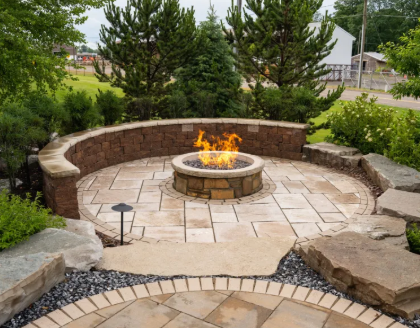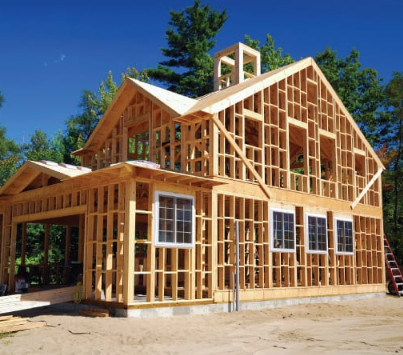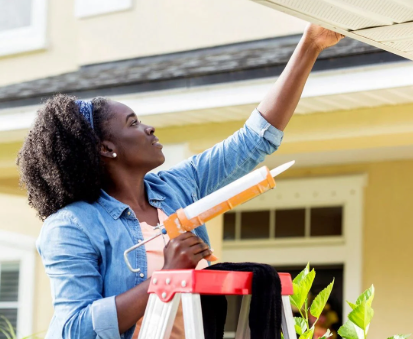Building a home is a thrilling journey. Discover step-by-step guidance to understand the ten essential stages of construction.
1. Preparing the Lot and Building the Foundation
Site preparation and laying the foundation are usually handled by the same construction team. However, if the land is heavily wooded, a specialized crew may be required to clear the site. Bulldozers and excavators are used to remove rocks, debris, trees, and any underground septic systems. Contractors then use wooden forms to shape the concrete foundation, leaving channels for drainage. Wooden footing is added to support the future weight of the house.
In the United States, about 15% of households rely on private well water instead of municipal supplies. If your new home will use a private water system, the well is usually installed before the wooden foundation is placed.
For homes with basements, concrete is poured into pre-prepared frames before the foundation is set, and basement walls are built next. For single-story houses, waterproof membranes are applied to walls and floors once the foundation cures, leaving space for plumbing and electrical systems.
Note: After the foundation cures, local inspectors will check compliance with building codes. They review the foundation, flooring, reserved plumbing and electrical channels, and basement work. Once approved, the builder removes the concrete forms and moves to the next step—framing.
2. Framing the House
With the foundation complete, walls, floors, roof structures, and window and door frames are built—essentially forming the “skeleton” of the home. Since most U.S. homes are wood-framed, walls are built using plywood of varying thickness and wrapped with protective sheathing. This step prevents outside moisture from seeping in, which could damage wood and cause mold.
3. Installing Plumbing, Electrical, and HVAC Systems
Once the framing is complete, contractors install wiring, plumbing, waste pipes, and heating/cooling ductwork. Many builders also move in large items like bathtubs at this stage since open space makes transport easier.
HVAC systems, furnaces, and ductwork are installed now, followed by electrical wiring and internet cables. Typically, wiring is done last because wires can be routed around plumbing and ducts more easily.
Note: Inspections for framing and utility installations usually take place two or three times, depending on builder requirements.
4. Installing Insulation
Insulation plays a vital role in maintaining indoor comfort. Its effectiveness is measured by an R-value—the higher the value, the better the material resists heat transfer. Many U.S. homes use insulation in walls, attics, floors, and sometimes basements. Common materials include fiberglass, foam, and organic fiber composites. Some builders also use mineral blends, recycled materials, or concrete blocks depending on climate needs.
Insulation comes in rolls, blocks, or panels, often made of fiberglass or foil with foam or natural fibers inside. These are lightweight, easy to install, and widely used. Spray foam insulation is another option for irregular spaces; it expands to fill gaps but is more expensive.
Fiberglass and mineral wool blends are often used in attics and between interior walls. Some are lined with paper backing to prevent heat loss, while premium types include fire-resistant coatings.
5. Interior Drywall and Exterior Finishes
Inside, drywall (also called Sheetrock® in the U.S.) is installed to form walls. Seams are taped to prevent gaps, and a primer coat is applied for smooth painting. On the exterior, materials like bricks, stone, or stucco are used for finishes.
Note: Many builders use “Sheetrock” as a general term for drywall due to the popularity of that brand.
6. Interior Fixtures, Driveway, and Porch
Now comes the stage most people recognize as interior finishing. Cabinets, kitchen fixtures, and trim work for doors and windows are installed. Walls are painted or wallpapered.
Outside, builders may begin work on driveways, sidewalks, and porches. Some prefer to wait until all interior work is done to avoid damage from heavy trucks. Others install them earlier to prevent mud tracking during construction.
7. Flooring and Countertops
Tile, hardwood flooring, and countertops are installed during this phase. Outdoors, drainage systems may be added, and landscaping preparation begins.
8. Lighting and Bathroom Fixtures
Lighting fixtures, switches, and outlets are installed, along with HVAC systems and air conditioning units. Sinks, faucets, and toilets are also put in place.
9. Interior and Exterior Décor
After cleaning, final decorative elements like mirrors, curtains, and carpets are added inside. Landscaping, gardening, and outdoor design take place outside.
Note: At this stage, builders should apply for a Certificate of Occupancy, which confirms the home meets all safety and building requirements. If inspections fail, re-inspections are required until approval is granted.
10. Final Walkthrough and Inspection
Once construction is complete, the builder conducts a walkthrough with the homeowner, explaining how systems work and what is covered under warranty. This is the homeowner’s chance to request adjustments or fixes. It’s also important to carefully check details like countertops, flooring, and paint since small cosmetic issues may later be harder to claim as builder mistakes.
Final Reminders
Throughout the process, multiple inspections ensure compliance with local codes. Homeowners should also check workmanship carefully and raise concerns before moving in. Some issues may only become visible after living in the home, so prompt communication with the builder is key.
Buyers may also bring in independent inspectors, which is allowed in the U.S., as long as the builder is notified in advance. Skipping inspections may not guarantee quality, but attending them helps homeowners fully understand their house’s structure and systems.
For safety and logistics, builders generally discourage unannounced site visits. Many schedule several official walkthroughs, but if you want extra visits, always inform the builder beforehand.





